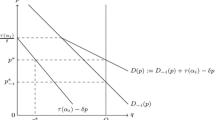Abstract
This paper examines pollution regulation in a dynamic setting with complete information. We show that tradeable pollution permits may not achieve the social optimum even when the permit market is perfectly competitive. The reason is that the optimal tradeable permits regulation will typically be time inconsistent. We then show that pollution taxes can achieve the first best and are time consistent.
Similar content being viewed by others
References
Baumol, William J. and Wallace E. Oates. 1988.The Theory of Environmental Policy, Second Edition. Cambridge UK: Cambridge University Press.
Bohm, Peter and Clifford Russell. 1985. “Comparative Analysis of Alternative Policy Instruments.” InHandbook of Natural Resource and Energy Economics, edited by Allan Kneese and James Sweeney. Amsterdam: North-Holland.
Dasgupta, Partha, Peter Hammond, and Eric Maskin. 1980. “On Imperfect Information and Optimal Pollution Control.”Review of Economic Studies 47(5): 857–860.
Downing, Paul B., and Lawrence J. White. 1986. “Innovation in Pollution Control.”Journal of Environmental Economics and Management 13(1): 18–29.
Downing, Paul B., and Lawrence J. White. 1990. “The Environment.”The Economist September 8, supplement.
Fudenberg, Drew, and Jean Tirole. 1991.Game Theory. Cambridge MA: MIT Press.
Hahn, Robert W. 1989. “Economic Prescriptions for Environmental Problems.”Journal of Economic Perspectives 3(2): 95–114.
Kydland, Finn, and Edward Prescott. 1977. “Rules Rather Than Discretion.”Journal of Political Economy 85: 473–491.
Malik, Arun S. 1991. “Permanent Versus Interim Regulations: A Game-Theoretic Analysis.”Journal of Environmental Economics and Management 21(2): 127–139.
Milliman, Scott R., and Raymond Prince. 1989. “Firm Incentives to Promote Technological Change in Pollution Control.”Journal of Environmental Economics and Management 17(3): 247–265.
Nichols, Albert. 1984.Targeting Economic Incentives for Environmental Protection. Cambridge MA: MIT Press.
Schelling, Thomas C. 1960.The Strategy of Conflict. Cambridge MA: Harvard University Press.
Spulber, Daniel F. 1986. “Optimal Environmental Regulation under Asymmetric Information.”Journal of Public Economics 35: 163–181.
Tietenberg, Tom. 1974. “The Design of Property Rights for Air Pollution Control.”Public Policy 22: 275–292.
Tietenberg, Tom. 1985.Emissions Trading. Washington DC: Resource for the Future.
Turnovsky, Stephen, and William Brock. 1980. “Time Consistency and Optimal Government Policies in Perfect Foresight Equilibrium.”Journal of Public Economics 13: 183–212.
Weitzman, Martin. 1974. “Prices vs. Quantities.”Review of Economics Studies 41: 477–91.
Author information
Authors and Affiliations
Additional information
We thank Claudio Mezzetti, Wally Oates, and Paul Rhode for helpful comments. The last two authors thank the National Science Foundation for financial support.
Rights and permissions
About this article
Cite this article
Biglaiser, G., Horowitz, J.K. & Quiggin, J. Dynamic pollution regulation. J Regul Econ 8, 33–44 (1995). https://doi.org/10.1007/BF01066598
Issue Date:
DOI: https://doi.org/10.1007/BF01066598




